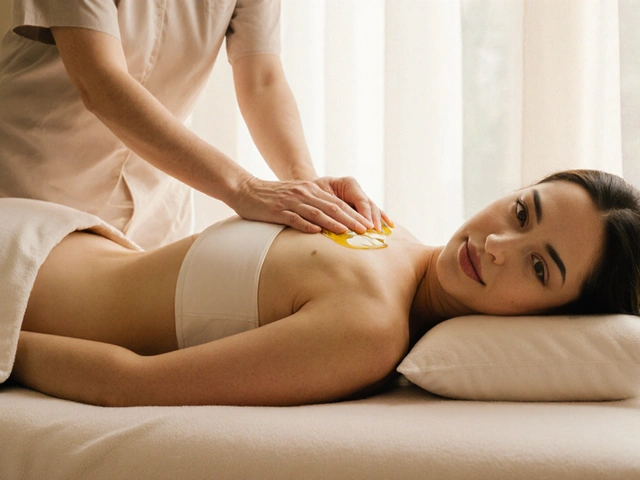Self-Massage Tips That Actually Work — Fast, Simple, At Home
You don’t need a spa to feel better. With a few clear moves and a couple of cheap tools, you can ease tight shoulders, calm a headache, and sleep deeper tonight. These tips focus on what to do, how hard to press, and when to stop so you get results without making things worse.
Quick self-massage moves you can do anywhere
Neck and shoulders: Sit tall. Use your thumbs to press the base of your skull and the tops of your shoulders. Hold steady pressure for 5–10 seconds, then slowly roll your thumbs in small circles. Repeat across the tight spots. Breathe out as you press — it helps the muscle relax.
Upper back (desk neck): Wedge a tennis ball between your shoulder blade and a wall. Lean into the ball and roll up and down slowly for 1–2 minutes on each side. Stop if you feel sharp pain. This breaks up knots and saves your hands.
Lower back: Lie on your back with a rolled towel under the small of your back. Gently arch and relax over the towel while breathing deeply for 30–60 seconds. Avoid heavy pressure directly on the spine; aim for the muscles beside it.
Hands and forearms: If you type a lot, press the palm with the thumb of the opposite hand and squeeze along each finger base for 3–5 seconds. For forearms, use long strokes from wrist to elbow to improve circulation and ease tightness.
Feet: Stand and press a golf or massage ball into the arch, rolling from heel to toes for 1–3 minutes per foot. This calms plantar pain and helps you feel lighter on your feet.
Tools, timing, and safety — get better results
Tools: Use what you have — tennis ball, massage ball, foam roller, or a warm towel. Hot or cold packs can help: warm before massaging to loosen tissue; cold after heavy work to reduce inflammation.
Pressure and timing: Aim for firm but comfortable pressure — a 6 out of 10 on a pain scale. Hold trigger points for 10–15 seconds, then release slowly. Limit focused work on one spot to 2–3 minutes; longer can irritate tissue.
Breathing and posture: Breathe slowly and don’t hold your breath. Keep good posture while massaging so you’re not creating new strain. Small, relaxed movements beat aggressive digging every time.
Safety pointers: Stop if you have sharp pain, numbness, swelling, or recent injury. If you’re pregnant, have blood clots, or recent surgery, check with a healthcare pro first. Self-massage helps many everyday aches, but it doesn’t replace a proper diagnosis when something feels off.
Try this plan: 3–5 minutes on neck/shoulders each evening, 1–2 minutes of foot rolling after long days, and a 5-minute foam roll session twice a week. Small, consistent habits beat occasional marathon sessions. Your body will thank you.

Trigger Point Massage: The Secret to Relieving Muscle Pain
Discover how trigger point massage can target stubborn muscle pain and tension fast. Get the low-down on what trigger points really are, why they hurt so much, and what you can do about them. Learn practical tips for finding your own trouble spots and using simple massage techniques to get lasting relief. Understand the science without the jargon, and pick up some tricks that you can use right away at home. Whether you sit at a desk or crush it at the gym, this guide makes muscle relief totally doable.
Categories
- Health and Wellness (148)
- Alternative Therapies (86)
- Massage Therapy (40)
- Travel and Culture (15)
- Beauty and Skincare (9)
- Holistic Health (8)
- Health and Fitness (5)
- Spirituality (5)
- Other (2)
- Personal Development (2)
Popular Articles

Ortho-Bionomy: Transforming Body Healing Naturally
May, 31 2025


